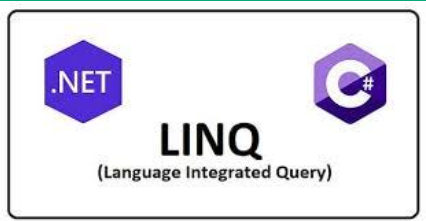LINQ (Language-Integrated Query) in C#
Understanding LINQ:
LINQ is a powerful feature introduced in C# 3.0 as a part of the .NET Framework 3.5 release. It enables developers to write queries against collections (such as arrays, lists, and dictionaries), databases, XML, and other data sources using a unified syntax. LINQ queries are written in a declarative style, allowing developers to express what data they want rather than how to retrieve it. This abstraction layer simplifies data manipulation tasks and enhances code readability and maintainability.
Methods in LINQ:
LINQ provides a rich set of methods for querying data, each serving a specific purpose. Let’s explore some of the most commonly used LINQ methods in detail:
Where: The ‘Where’ method filters elements from a collection based on a specified condition. It takes a predicate delegate that defines the condition. For example:
![]()
This query filters out even numbers from the numbers collection.
Select: The ‘Select’ method projects each element of a sequence into a new form. It transforms the elements using a selector function. For example:
![]()
This query calculates the square of each number in the numbers collection.
OrderBy / OrderByDescending: These methods sort the elements of a sequence in ascending or descending order based on a key. They take a key selector function to extract the key for sorting. For example:
![]()
This query sorts the numbers collection in ascending order.
GroupBy: The ‘GroupBy’ method groups the elements of a sequence based on a specified key. It returns a collection of groups, each containing a key and a sequence of elements. For example:
![]()
This query groups the numbers collection into two groups: even and odd numbers.
Join: The ‘Join’ method performs an inner join between two sequences based on a common key. It combines matching elements from both sequences into result elements. For example:

This query joins the students and scores collections based on the ID and StudentID properties, respectively.
Aggregate: The ‘Aggregate’ method applies an accumulator function over a sequence. It iteratively combines the elements of the sequence using the accumulator function. For example:
![]()
This query calculates the sum of all numbers in the numbers collection.
Any / All: These methods determine whether any or all elements of a sequence satisfy a condition. Any checks if any element satisfies the condition, while all checks if all elements satisfy the condition. For example:
![]() This query checks if there are any even numbers in the numbers collection.
This query checks if there are any even numbers in the numbers collection.
Distinct: The ‘Distinct’ method returns distinct elements from a sequence. It removes duplicate elements from the sequence. For example:
![]()
This query removes duplicate numbers from the numbers collection.
Skip / Take: These methods allow you to skip a specified number of elements (Skip) or take a specified number of elements (Take) from the beginning of a sequence. They enable pagination or slicing of sequences. For example:
![]()
This query skips the first 5 elements and takes the next 10 elements from the numbers collection.
Advantages of LINQ:
LINQ offers numerous advantages that make it a preferred choice for data querying and manipulation tasks in C# applications:
Declarative Syntax: LINQ offers a declarative syntax, making queries more readable and expressive compared to traditional looping constructs. Developers can focus on what data they want rather than how to retrieve it, leading to more concise and understandable code.
Integration with C# Language: LINQ integrates seamlessly with the C# language, allowing developers to write queries directly within their C# code. This tight integration simplifies development and maintenance by eliminating the need for separate query languages or APIs.
Type Safety: LINQ provides strong typing, which helps catch errors at compile-time rather than runtime. This ensures that the query is type-safe and reduces the chance of runtime errors, leading to more robust and reliable code.
Query Optimization: LINQ providers (such as LINQ to SQL or LINQ to Entities) optimize queries for the underlying data source, improving performance. Queries are translated into efficient SQL queries, reducing network overhead and improving scalability.
Code Reusability: LINQ queries can be easily reused across different parts of an application, promoting code reusability and maintainability. Developers can encapsulate common query logic into reusable methods or query expressions, reducing code duplication and enhancing productivity.
Disadvantages of LINQ:
While LINQ offers significant benefits, it also comes with certain limitations and challenges:
Learning Curve: LINQ and its various methods may require some learning effort, especially for beginners. Understanding query operators, expression trees, and provider-specific behaviors can be challenging, requiring developers to invest time in learning and experimentation.
Performance Overhead: LINQ queries may introduce some performance overhead compared to handwritten SQL queries, particularly for complex operations or large datasets. While LINQ providers optimize queries, developers should be mindful of performance implications and strive to write efficient queries.
Limited Provider Support: Not all data sources have LINQ provider support, which may limit its applicability in certain scenarios. LINQ providers may also have limitations or quirks that developers need to work around, requiring them to resort to alternative approaches or techniques.


Leave a Reply
Want to join the discussion?Feel free to contribute!